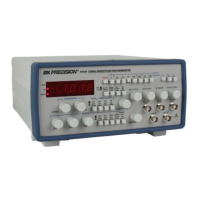GUIDEBOOK
TO
FUNCTION
GENERATORS
1031 SEGOVIA CIRCLE
PLACENTIA, CA 92870-7137
(714) 237-9220 FAX (714) 237-9214
www.bkprecision.com
Function Generators are one of the most
important and versatile pieces of test equip-
ment that a Technician or Engineer can use. In
both design and troubleshooting, the circuit in
question often requires a signal to simulate its
normal operation. The specific type of signal
can vary widely from one circuit to another.
Modern function generators are able to pro-
vide a very wide variety of signals, which will
meet a vast majority of these requirements.
Even today’s most basic units are capable of
sine, square, and triangle outputs over a range
of frequencies, from less than 1 Hz to at least
1 MHz, with variable amplitude and
adjustable DC offset. Many generators
include extra features, such as higher fre-
quency capability, variable symmetry, fre-
quency sweep, AM and FM operation, and
gated burst mode.
Although applications for function gener-
ators are virtually unlimited, here are just a
few of the more common uses:
• Research and development
• Secondary and post secondary
educational institutions
• Electronic and electrical equipment
repair shops.
• Consumer products repair shops
• Government repair facilities
• Electronic hobbyists
In order to use a function generator to its
best advantage, the Technician or Engineer
should have a basic understanding of how a
function generator works, as well as a good
understanding of the unit's controls, features,
and operating modes. This guidebook is use-
ful to those with little knowledge of function
generators, as well as the experienced
Technician or Engineer who wishes to refresh
his/her memory or explore new uses for func-
tion generators.
1

